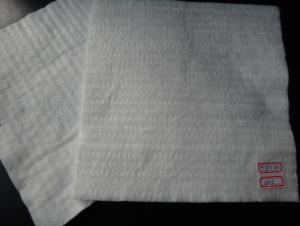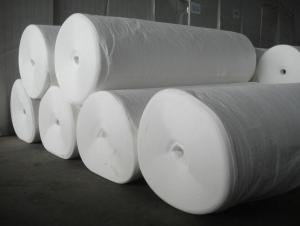High Strength non woven geotextile for Road andRailway construction
- Loading Port:
- Tianjin
- Payment Terms:
- TT OR LC
- Min Order Qty:
- -
- Supply Capability:
- 5000rolls m²/month
OKorder Service Pledge
OKorder Financial Service
You Might Also Like
High Strength non woven geotextile for Road andRailway construction :
Made from PP (polypropylene) or PET (polyester) short fiber by nonwoven needlepunched manu-
Facturing process, it has isolation, filtration, drainage, reinforcement,protection and maintenance
etc. Function.
Specification of HighStrength nonwoven geotextile for Road and Railway construction :
1.80G/M2 - 1500G/M2
2. Lm-8m in roll width, the length as clients ' request
Property of HighStrength nonwoven geotextile for Road and Railway construction :
I. Good flexibility, resistant to corrosion, resistant to acids and alkalis,anti-oxidation
2. Separation, filtration, drainage, reinforcement, protection, and maintenancefunction
Application of HighStrength nonwoven geotextile for Road and Railway construction :
1.. Water conservancy project and hydropower project
2. Road paving, railway
3. Airport and port
4. River bank protection and tunnel
5. Environmental protection, etc
Production standard HighStrength nonwoven geotextile for Road and Railway construction :
G B/T17638-1998
JT/T 520-2004
- Q:What are the specifications for geotextiles in civil engineering projects?
- Geotextiles used in civil engineering projects have specific specifications that include factors such as weight, tensile strength, permeability, and durability. The weight of the geotextile is typically measured in grams per square meter (gsm) and can vary depending on the specific application. Tensile strength refers to the material's ability to resist breaking under tension and is measured in units like kilonewtons per meter (kN/m). Permeability is a crucial factor, as geotextiles should allow water to pass through while preventing the movement of soil particles. Lastly, durability is essential to ensure the geotextile can withstand the environmental conditions it will be exposed to, such as UV exposure or chemical resistance.
- Q:How do geotextiles aid in the reduction of differential settlement?
- Geotextiles aid in the reduction of differential settlement by providing a stable and uniform base for the construction of roads, embankments, and foundations. They distribute the load more evenly, improving soil stability and preventing differential settlement, which occurs when different areas of the soil settle at different rates, leading to uneven surfaces and potential structural damage.
- Q:Road overhaul of the original concrete pavement after shaving asphalt, anti-cracking is geotextile or geogrid more
- Generally used in the geotextile, generally used in soft foundation reinforcement treatment; slope protection; road anti-reflective crack structure layer; drainage system; green belt
- Q:How do geotextiles improve the performance of asphalt overlays?
- Geotextiles improve the performance of asphalt overlays by providing reinforcement and separation between the existing pavement and the new asphalt layer. These fabrics help distribute the load and prevent the mixing of materials, reducing cracking and increasing the overall durability and lifespan of the overlay.
- Q:Can geotextiles be used in land reclamation projects?
- Yes, geotextiles can be used in land reclamation projects. They are often utilized for erosion control, soil stabilization, and drainage purposes in these projects. Geotextiles help to prevent soil erosion and provide a stable base for vegetation growth, making them a valuable tool in land reclamation efforts.
- Q:Will geotextiles generally use where?
- Transportation, water conservancy, environmental protection and other engineering fields
- Q:What are the limitations of using geotextiles?
- Some limitations of using geotextiles include their limited strength and durability compared to traditional construction materials, their susceptibility to damage from UV radiation and chemical exposure, and their potential for clogging and reduced filtration efficiency over time. Additionally, geotextiles may not be suitable for applications requiring high tensile strength or for areas with high groundwater flow rates.
- Q:How do geotextiles interact with other geosynthetic materials?
- Geotextiles interact with other geosynthetic materials by providing reinforcement, filtration, separation, and drainage functions. They can be used in combination with geogrids, geomembranes, geocells, and other geosynthetics to enhance the overall performance and effectiveness of geotechnical engineering projects.
- Q:What is the effect of highway geotextile on highway construction?
- Highway geotextile is a new type of civilized artifacts in the construction of the time, laying highway geotextile can improve the carrying capacity of the road, can improve the use of the road in the process of structural damage. As the geotextile has the role of shock absorption, and has a high elasticity and resistance to deformation, so you can make the road to bear the load and stress more uniform. In the project using Hongxiang new geotextile can also improve the rigidity of the road, help to reduce road cracks.
- Q:How are geotextiles affected by biological factors?
- Geotextiles can be affected by biological factors such as microbial degradation, plant growth, and colonization by organisms. These factors can deteriorate the material, leading to reduced strength, increased permeability, and potential failure of geotextiles in various applications.
1. Manufacturer Overview |
|
|---|---|
| Location | |
| Year Established | |
| Annual Output Value | |
| Main Markets | |
| Company Certifications | |
2. Manufacturer Certificates |
|
|---|---|
| a) Certification Name | |
| Range | |
| Reference | |
| Validity Period | |
3. Manufacturer Capability |
|
|---|---|
| a)Trade Capacity | |
| Nearest Port | |
| Export Percentage | |
| No.of Employees in Trade Department | |
| Language Spoken: | |
| b)Factory Information | |
| Factory Size: | |
| No. of Production Lines | |
| Contract Manufacturing | |
| Product Price Range | |
Send your message to us
High Strength non woven geotextile for Road andRailway construction
- Loading Port:
- Tianjin
- Payment Terms:
- TT OR LC
- Min Order Qty:
- -
- Supply Capability:
- 5000rolls m²/month
OKorder Service Pledge
OKorder Financial Service
Similar products
New products
Hot products
Related keywords





























